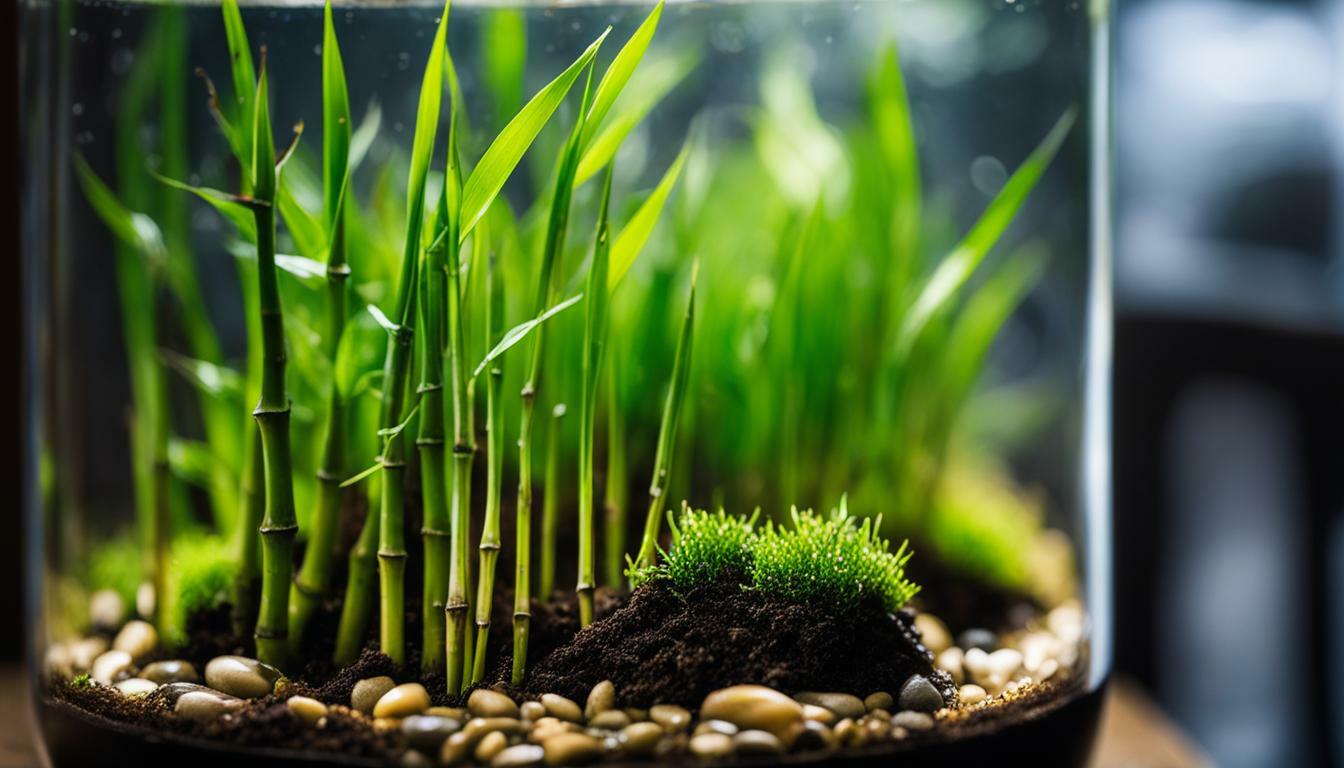Have you ever wanted to create your own green oasis at home? With terrarium plants miniature bamboo, you can cultivate a tranquil and stunning display of nature in your very own terrarium.
Terrariums are self-sustaining ecosystems that are perfect for growing plants like miniature bamboo. They require a glass container with no lid, and the base should consist of pebbles, charcoal, and potting soil. Lucky bamboo, which is actually a member of the dracaena genus, is a versatile plant that can be grown in terrariums. To grow lucky bamboo in a terrarium, fill the container with sand, moss, gravel, stones, soil, and activated charcoal. Then, plant a young stalk of Dracaena Sanderiana in the soil. Terrariums should be kept in diffused light and require occasional watering, while avoiding overwatering. Cleaning the terrarium regularly is important to prevent water spots or algae buildup. Overall, terrariums offer a beautiful and functional environment for growing miniature bamboo and other plants.
Key Takeaways:
- Terrariums provide a self-sustaining ecosystem for growing miniature bamboo.
- Lucky bamboo, a member of the dracaena genus, is a versatile plant suitable for terrariums.
- Proper terrarium setup includes a glass container with pebbles, charcoal, and potting soil.
- Maintain diffused light and occasional watering to keep miniature bamboo healthy.
- Clean the terrarium regularly to prevent water spots and algae buildup.
The Joy of Terrariums: Bringing Nature Indoors
Terrariums have gained immense popularity due to their ability to bring a slice of nature into your indoor space, allowing you to create a captivating and low-maintenance miniature garden. These self-sustaining ecosystems are not only decorative but also offer numerous benefits for plant enthusiasts.
One of the best things about terrariums is that they provide an ideal environment for a wide variety of plants. From ferns and succulents to mosses and miniature bamboo, you have plenty of options to choose from when selecting the best plants for your terrarium. These plants thrive in the controlled environment of a terrarium, requiring minimal care and attention.
When it comes to creating a terrarium, the possibilities are endless. You can play with different textures, colors, and sizes of plants to design your own unique miniature garden. Adding decorative elements such as rocks, shells, or even miniature figurines can further enhance the visual appeal of your terrarium.
Whether you place your terrarium on a tabletop or hang it from the ceiling, it will undoubtedly become a captivating focal point in any room. The beauty and tranquility of nature that terrariums bring to your indoor space can help reduce stress levels and create a soothing atmosphere.
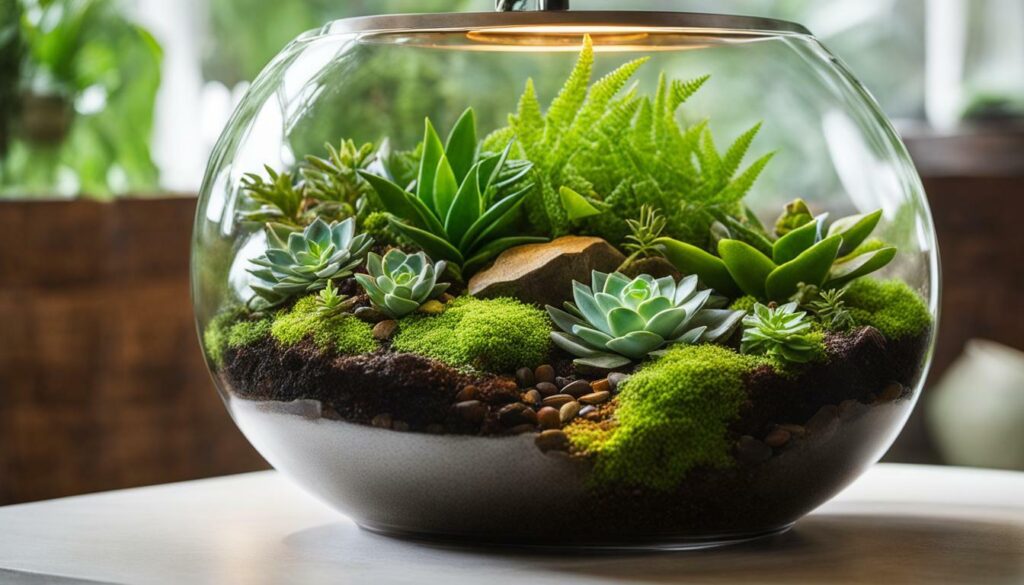
| Plant | Light Requirements | Watering |
|---|---|---|
| Ferns | Low to medium light | Keep soil moist |
| Succulents | Bright, indirect light | Water sparingly |
| Mosses | Low to medium light | Mist regularly |
| Miniature Bamboo | Medium to bright light | Water when soil is dry |
So, whether you are a seasoned plant enthusiast or just starting your journey into indoor gardening, terrariums offer a fantastic opportunity to bring nature into your home. With their captivating beauty and the ease of care they require, terrariums are the perfect way to indulge your green thumb and create a stunning indoor oasis.
Creating the Perfect Terrarium for Miniature Bamboo
To ensure the health and growth of your miniature bamboo plants, it’s essential to create an ideal terrarium environment that mimics their natural habitat. Terrariums are self-sustaining ecosystems that provide the perfect conditions for small bamboo plants to thrive. These miniature gardens require a glass container without a lid, allowing for proper airflow and moisture control.
The base of the terrarium should consist of a layer of pebbles for drainage, followed by a layer of activated charcoal to prevent odors and promote healthy root development. On top of the charcoal, add potting soil specifically formulated for terrariums. This soil should have good drainage properties while retaining enough moisture for the plants.
For the mini bamboo plant, choose a small variety that is suitable for indoor terrariums. Some popular options include Bambusa multiplex, Pleioblastus fortunei, and Sasaella glabra. These bamboo species are well-suited for the limited space of a terrarium and can thrive in the controlled environment.
| Bamboo Species | Size | Care Requirements |
|---|---|---|
| Bambusa multiplex | Up to 2 feet | Partial sunlight, moderate watering |
| Pleioblastus fortunei | Up to 1 foot | Partial to full sunlight, regular watering |
| Sasaella glabra | Up to 1.5 feet | Partial to full sunlight, consistent watering |
Miniature bamboo plants add a touch of elegance and tranquility to any terrarium setup. Their delicate leaves and slender stems create a serene atmosphere and bring a sense of nature indoors.
Once you’ve chosen the right bamboo species, carefully plant them in the terrarium, ensuring the roots are well-covered with soil. Gently pack the soil around the base of the plant, making sure it is secure. After planting, water the terrarium lightly to settle the soil and provide initial moisture for the plants.
Place the terrarium in a location with diffused light, as direct sunlight may scorch the delicate foliage. It’s important to monitor the moisture levels in the terrarium and water accordingly. Be mindful not to overwater, as excessive moisture can lead to root rot. You can use a spray bottle or a small watering can with a narrow spout to water the plants, allowing for better control over the amount of water.
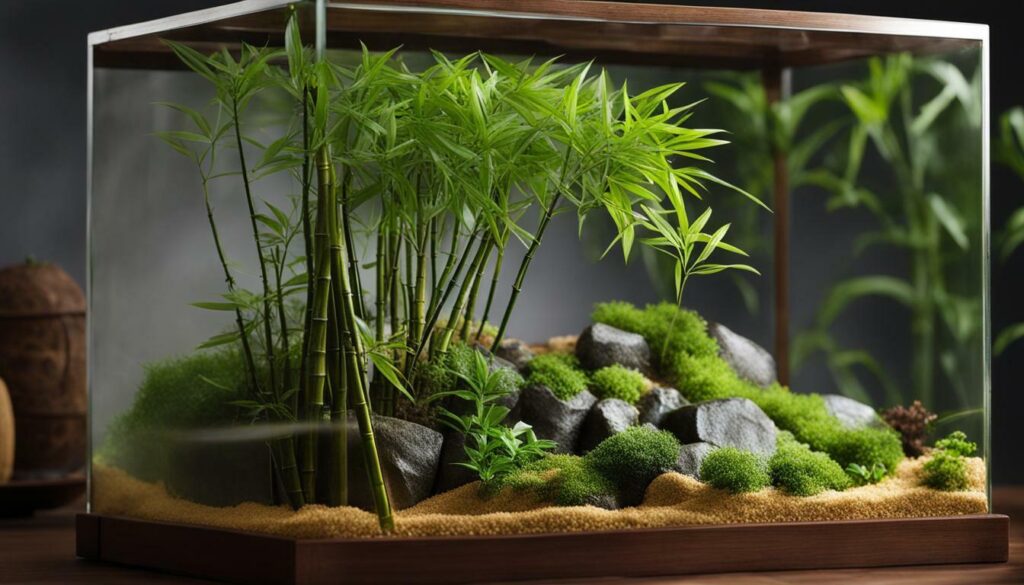
Regular maintenance is key to keeping your terrarium healthy. Remove any dead or yellowing leaves to maintain the overall aesthetic appeal and prevent the spread of disease. Cleaning the terrarium regularly is also important to prevent water spots or algae buildup. Simply wipe the glass with a soft cloth or sponge to remove any debris or residue.
By creating the perfect terrarium environment and providing proper care, your miniature bamboo plants will flourish and bring a touch of beauty and serenity to your indoor space. Enjoy the natural elegance that miniature bamboo brings and let your terrarium become a captivating centerpiece in your home or office.
Choosing the Right Miniature Bamboo Species
When selecting miniature bamboo plants for your terrarium, it’s crucial to choose species that are well-suited to the confined space and conditions of an indoor environment. There are several varieties of miniature bamboo that thrive in terrariums, offering beauty and elegance to any space. Here are a few popular options:
1. Pleioblastus pygmaeus
This dwarf bamboo species, also known as dwarf or pygmy bamboo, is a perfect choice for small terrariums. It has delicate, green foliage that adds a touch of grace to any miniature garden. Pleioblastus pygmaeus grows well in low light conditions and prefers well-draining soil. With proper care, it can reach a height of about 6 inches, making it an ideal option for small-scale terrariums.
2. Sasaella ramosa
Also known as umbrella bamboo, Sasaella ramosa is a compact variety that thrives in terrarium environments. It has beautiful, arching foliage that adds a sense of movement to the overall design. This bamboo species prefers bright, indirect light and slightly acidic soil. With proper care, it can reach a height of about 8 inches, making it a versatile choice for medium-sized terrariums.
3. Fargesia rufa
Fargesia rufa, commonly known as red panda bamboo, is a more vibrant option for terrariums. It features striking red stems and lush green leaves, creating a visually appealing contrast. This bamboo species prefers indirect light and well-drained, slightly acidic soil. It can reach a height of about 12 inches and is perfect for larger terrariums or as a centerpiece in a terrarium display.
Remember to consider the size and height of your terrarium when selecting miniature bamboo species. It’s essential to provide enough space for the plants to grow and thrive. By choosing the right miniature bamboo species, you can create a visually stunning terrarium that brings a touch of nature into your indoor space.
| Miniature Bamboo Species | Height | Light Requirements | Soil Type |
|---|---|---|---|
| Pleioblastus pygmaeus | Up to 6 inches | Low light | Well-draining |
| Sasaella ramosa | Up to 8 inches | Bright, indirect light | Slightly acidic |
| Fargesia rufa | Up to 12 inches | Indirect light | Well-drained, slightly acidic |
Terrarium Care for Miniature Bamboo
Proper care is essential for the long-term health and vibrant growth of terrarium plants with miniature bamboo, ensuring that your mini bamboo garden thrives in its enclosed environment. Terrariums provide a unique and beautiful way to enjoy the beauty of miniature bamboo while creating a self-sustaining ecosystem. By following a few simple guidelines, you can ensure that your terrariums flourish and bring a touch of nature indoors.
When setting up your terrarium, it is important to provide the right conditions for your miniature bamboo. Start by choosing a glass container without a lid to allow proper air circulation. The base of your terrarium should consist of pebbles or gravel for drainage, followed by a layer of activated charcoal to keep the soil fresh. Lastly, add a layer of well-draining potting soil suitable for bamboo plants.
Once your terrarium is set up, it’s time to place your miniature bamboo inside. Lucky bamboo, a member of the dracaena genus, is an excellent choice for terrariums. Fill the container with sand, moss, gravel, stones, soil, and activated charcoal, creating a suitable environment for lucky bamboo’s growth. Carefully plant a young stalk of Dracaena Sanderiana in the soil, making sure it is secure and upright.
Proper lighting is crucial for the health of your terrarium plants. Place your terrarium in an area with indirect or diffused light, avoiding direct sunlight that could scorch the bamboo leaves. Regularly monitor the moisture level in the soil and water your miniature bamboo accordingly. It is important to maintain a balance; overwatering can lead to root rot, while underwatering can cause the bamboo to wilt. Remember to clean the terrarium regularly to prevent water spots or algae buildup, ensuring a clean and healthy environment for your miniature bamboo.
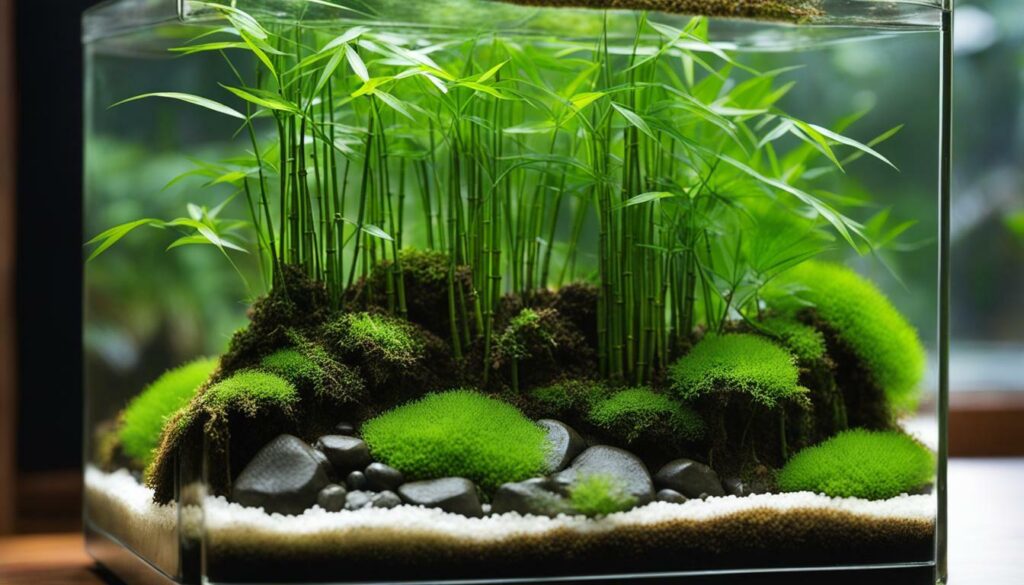
With proper care, your terrarium with miniature bamboo can be a beautiful and low-maintenance addition to your indoor space. Enjoy the tranquility and natural beauty of your mini bamboo garden, and watch as your plants thrive in their enclosed environment. Whether you’re a beginner or an experienced terrarium enthusiast, growing miniature bamboo in a terrarium is a rewarding and enjoyable experience.
Lucky Bamboo: A Versatile Plant for Terrariums
Lucky bamboo, scientifically known as Dracaena Sanderiana, is a popular choice for terrariums due to its ornamental appearance and adaptability to different growing conditions. Its slender, vibrant green stems and lush foliage add a touch of elegance to any terrarium setting. Whether you’re a beginner or an experienced plant enthusiast, lucky bamboo is a versatile plant that will thrive in your terrarium.
Lucky bamboo is not actually a bamboo; it belongs to the Dracaena genus, which is known for its low maintenance and hardiness. This makes it an excellent choice for those new to terrarium gardening.
To successfully grow lucky bamboo in your terrarium, you’ll need to provide the right environment. Start by selecting a suitable glass container with no lid. The base of your terrarium should consist of a layer of pebbles to improve drainage, followed by a layer of activated charcoal to filter the water and remove impurities. On top of the charcoal, add a layer of potting soil specifically formulated for terrariums.
Once your terrarium is prepared, you can plant a young stalk of Dracaena Sanderiana into the soil. Position it carefully, ensuring the roots are covered and secure. Then, surround the base of the plant with sand, moss, gravel, and stones to create an aesthetically pleasing arrangement.
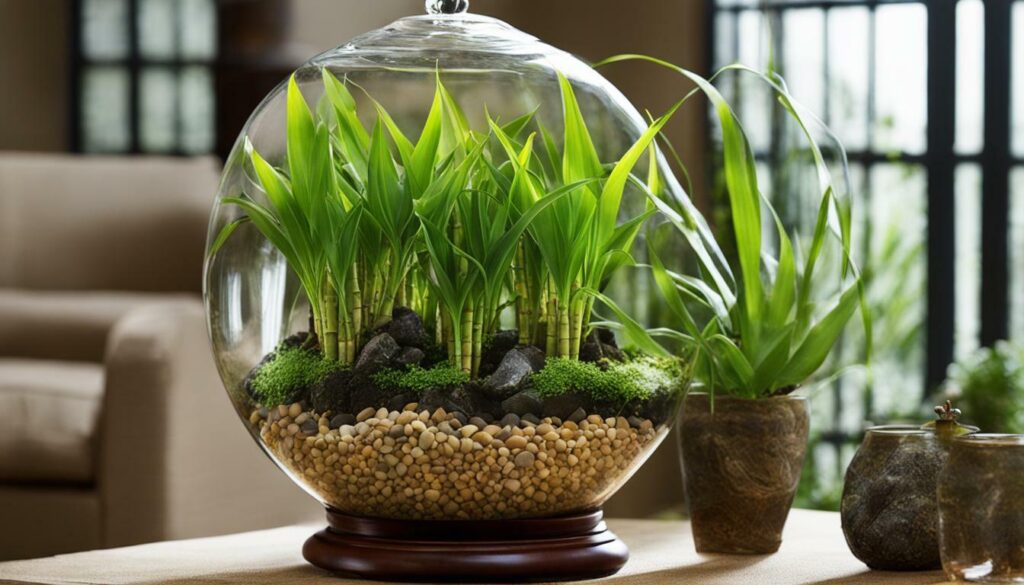
Table: Terrarium Care for Lucky Bamboo
| Aspect | Requirements |
|---|---|
| Light | Indirect or low-light conditions. Avoid direct sunlight. |
| Watering | Keep the soil lightly moist at all times. Water once or twice a week, or when the top inch of soil feels dry. |
| Temperature | Comfortable room temperature of 65-85°F (18-29°C). |
| Humidity | Moderate to high humidity is ideal. Mist the leaves occasionally to increase humidity levels. |
| Fertilizer | Use a balanced, water-soluble fertilizer once a month during the growing season. Follow the manufacturer’s instructions for application. |
To maintain the health and beauty of your terrarium, it’s important to follow proper care guidelines. Keep your terrarium in a location with diffused light to avoid scorching the leaves. Water the plant as needed, but avoid overwatering, as it can lead to root rot. Clean the terrarium regularly to prevent water spots or algae buildup, which can affect the overall aesthetics of your miniature bamboo garden.
In conclusion, lucky bamboo is a versatile and attractive plant that thrives in terrarium environments. With a little care and attention, you can enjoy the beauty of miniature bamboo while creating a serene and captivating indoor garden. So why not add a touch of green to your space with a lucky bamboo terrarium?
Maintaining a Healthy Terrarium Environment
To ensure the longevity and overall beauty of your terrarium, regular maintenance and cleaning are crucial to keep it in its optimal condition. Terrariums create a lush and captivating display of miniature plants, but without proper care, they can become susceptible to issues such as water spots or algae buildup. By following a few simple steps, you can maintain a healthy terrarium environment that will thrive for years to come.
First, it’s important to monitor the moisture levels in your terrarium. Overwatering is a common mistake that can lead to root rot and other plant diseases. Always check the moisture level of the soil before watering. If it feels damp, hold off on watering until it dries out a bit. Remember that terrariums are self-contained ecosystems with limited drainage, so it’s crucial not to overdo it.
In addition to watering, regular cleaning is essential for a clean and vibrant terrarium. Start by removing any fallen leaves or debris from the soil surface. You can use a pair of tweezers or small tongs to carefully pluck them out. Next, gently wipe the glass walls of the terrarium with a soft cloth or a paper towel to remove any smudges or fingerprints. If you notice any water spots or algae buildup on the glass, create a mixture of equal parts vinegar and water, and use a clean cloth to scrub away the stains. Be sure to rinse the glass thoroughly afterward to remove any residue.
To prevent excessive moisture and maintain proper air circulation, it’s a good idea to periodically remove the lid or open the terrarium for a brief period. This will allow fresh air to circulate and help prevent the growth of mold or mildew. If you notice any signs of mold or mildew on the plants or soil, take immediate action to address the issue. Remove the affected plant or clean the affected area with a damp cloth soaked in diluted hydrogen peroxide. Proper ventilation and cleanliness are key to a healthy terrarium environment.
| Cleaning Tips for Terrariums |
|---|
| Check soil moisture before watering |
| Remove fallen leaves and debris |
| Wipe glass walls to remove smudges |
| Clean water spots and algae with vinegar mixture |
| Open terrarium occasionally for ventilation |
| Address mold or mildew immediately |
By following these maintenance tips, you can ensure that your terrarium remains a beautiful and thriving ecosystem for your miniature bamboo and other plants. Regular cleaning, proper watering, and occasional ventilation are the keys to a healthy and vibrant terrarium. Enjoy the beauty of nature indoors and create a captivating display with your terrarium.
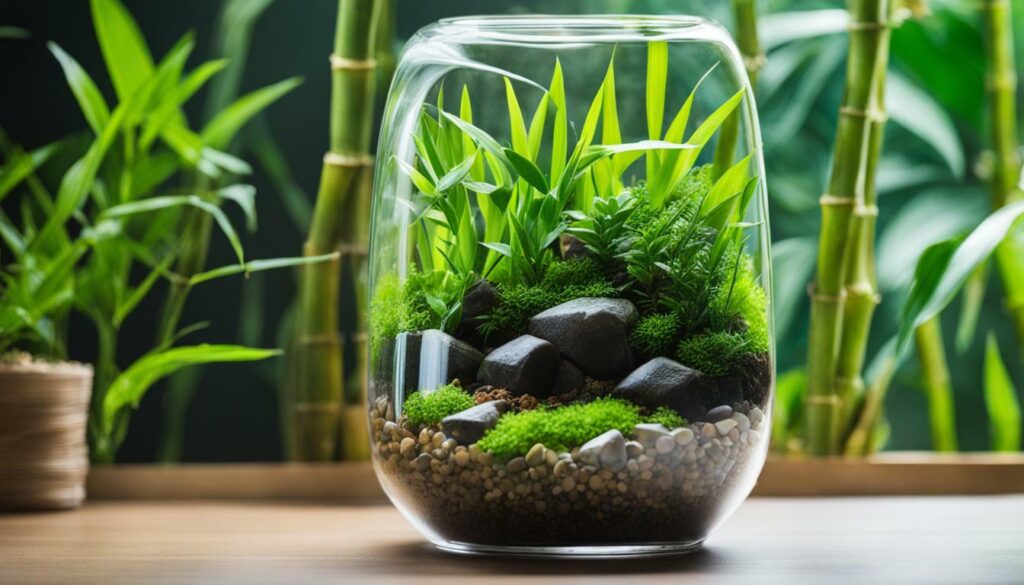
While terrariums provide a controlled environment for your miniature bamboo plants, certain issues may still arise. Here are some common problems you might encounter and how to deal with them effectively.
Mold
Mold can develop in a terrarium due to excessive moisture or poor air circulation. To address this issue, make sure your terrarium has proper ventilation by slightly opening the lid or removing it for a short period each day. Additionally, avoid overwatering your plants and remove any dead or decaying leaves promptly. If mold persists, you can lightly spray a fungicide solution on the affected areas.
Yellowing Leaves
Yellowing leaves can indicate various issues such as overwatering, inadequate lighting, or nutrient deficiencies. Check the moisture level of the soil and adjust your watering accordingly. Ensure your terrarium is placed in a location with sufficient indirect sunlight, as direct sunlight can scorch the leaves. Consider adding a balanced liquid fertilizer to provide the necessary nutrients.
Pests
Pests like aphids, mealybugs, or spider mites can sometimes infest terrariums. If you spot any pests, isolate the affected plant immediately to prevent further spread. For minor infestations, you can wipe the leaves with a gentle soap and water solution or use natural pest control methods like neem oil. If the infestation persists or becomes severe, consider using a commercial insecticide specifically formulated for indoor plants, following the instructions carefully.
Algae Growth
Algae growth can occur when there is excessive moisture and sunlight in the terrarium. To combat this issue, reduce the amount of watering and ensure the terrarium is not placed in direct sunlight. You can also physically remove the algae using a small brush or sponge. Additionally, adding a layer of activated charcoal or installing a small air circulating fan can help prevent algae growth by improving air circulation.
Remember, proper care and regular monitoring are key to maintaining a healthy terrarium environment for your miniature bamboo plants. By addressing these common issues promptly, you can ensure the long-term success and beauty of your indoor garden.
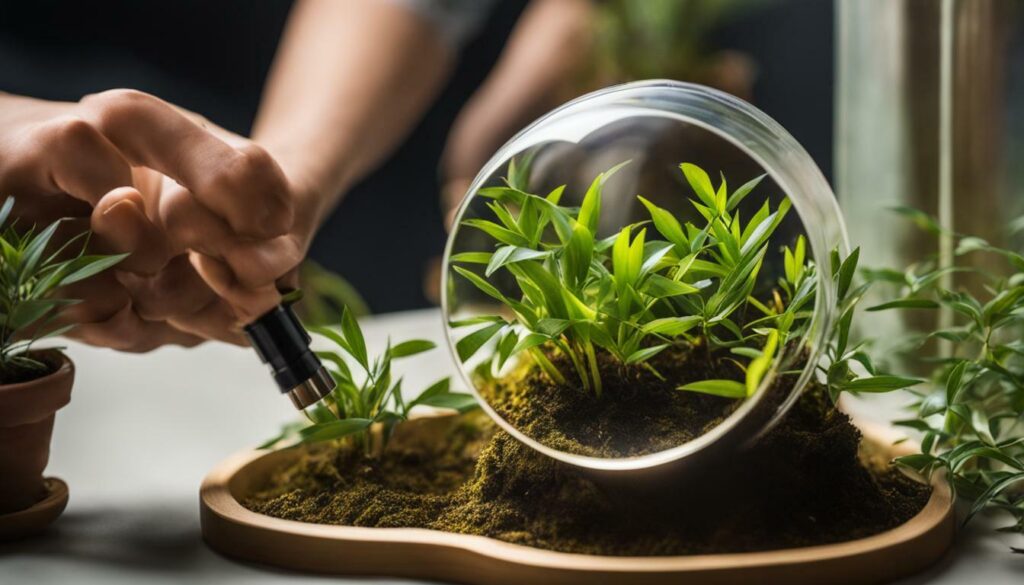
Terrariums with miniature bamboo plants are not only a nature lover’s delight but also an exquisite addition to any interior, bringing a touch of serenity and Zen beauty to your living or working space. These enchanting miniature gardens create a calming atmosphere and add a unique element of nature indoors. With their compact size and low maintenance, terrariums are perfect for people with limited space or busy schedules.
One of the best aspects of terrariums is their versatility in design. You can let your creativity flourish by choosing different containers, layers, and plant combinations. A terrarium with miniature bamboo as the centerpiece can be complemented with other terrarium plants, such as moss, ferns, succulents, or air plants. The contrasting textures and shades of green create a visually appealing display that adds to the overall ambiance of the space.
Whether you place your terrarium on a windowsill, work desk, or coffee table, it will effortlessly bring a sense of tranquility to your surroundings. The gentle rustle of the bamboo leaves and the peaceful atmosphere it creates can help reduce stress and promote relaxation. Its compact size also makes it an ideal gift for loved ones, bringing a touch of nature and positive energy into their lives.
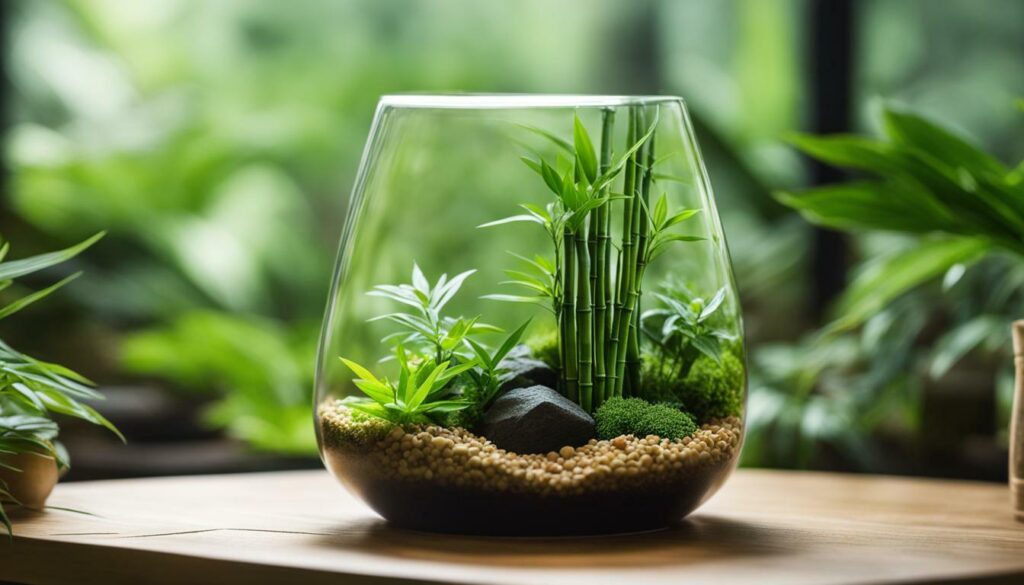
| Species | Growth Habit | Size | Care Requirements |
|---|---|---|---|
| Bambusa multiplex | Clumping Bamboo | 1-3 feet | Medium light, moist soil |
| Phyllostachys aurea | Running Bamboo | 3-5 feet | Bright light, well-drained soil |
| Pleioblastus fortunei | Groundcover Bamboo | 1-2 feet | Partial shade, moist soil |
When maintaining terrariums with miniature bamboo, it’s important to provide them with the right conditions. They thrive in indirect or filtered light, away from direct sunlight. Overexposure to light can cause the leaves to burn or turn yellow. Avoid overwatering as well, as excessive moisture can lead to root rot. It’s best to water the terrarium only when the soil feels slightly dry.
Cleaning the terrarium regularly is crucial to prevent water spots or algae buildup on the glass container. Gently wipe the glass with a soft cloth and avoid using harsh chemicals that can harm the plants. It’s also important to periodically trim any yellowing or dead leaves to maintain the terrarium’s aesthetic appeal.
In conclusion, the combination of miniature bamboo plants and terrariums creates a harmonious and visually pleasing addition to any space. The tranquility and beauty they bring make them an excellent choice for both plant enthusiasts and those looking for a unique decorative element. Explore the world of terrariums and miniature bamboo, and enjoy the serenity they bring to your daily life.
Discovering the Art of Terrarium Design
Creating a visually appealing terrarium with miniature bamboo plants is an art form that allows you to unleash your creativity and personalize your own miniature green world. Whether you prefer a minimalist approach or a more eclectic style, there are endless possibilities to explore. Best terrarium plants like miniature bamboo can be combined with other foliage and decorative elements to create stunning compositions that bring a touch of nature indoors.
When designing your terrarium, consider the size and shape of the container. A tall, thin container can create a vertical garden effect, while a wide, shallow container can offer a more expansive landscape. You can also experiment with layers of different textures, using rocks, pebbles, or sand to create a natural-looking base. Adding small figurines or decorative stones can add whimsy or elegance to your design.
To create depth and interest, vary the height and placement of the different plants within the terrarium. Combine different shades of green and different leaf shapes to create contrast and visual appeal. Miniature bamboo plants, with their delicate foliage and graceful stalks, make a beautiful centerpiece or focal point in any terrarium design. Their compact size also makes them suitable for smaller terrariums or arrangements.
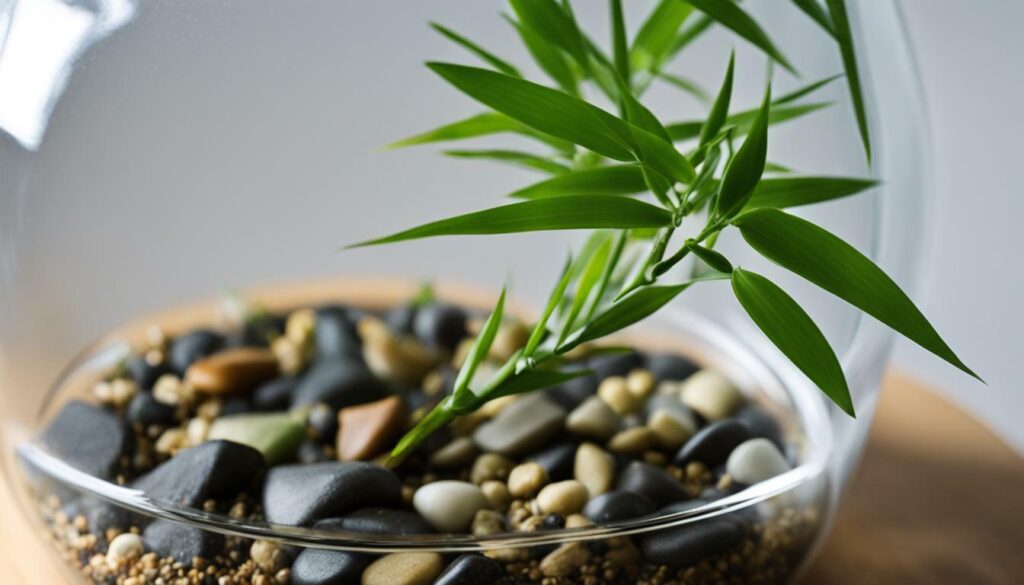
Don’t be afraid to think outside the box and incorporate unconventional materials into your terrarium design. Repurposing glass jars, vintage bottles, or even old fish tanks can add a unique touch to your creation. Remember to consider the lighting conditions and watering needs of the plants you choose, as these will also impact the overall design and maintenance of your terrarium.
Terrarium Design Tips:
- Experiment with different container shapes and sizes to create unique terrarium designs.
- Combine textures and materials, such as rocks, pebbles, or decorative elements, to add visual interest.
- Vary the height and placement of plants to create depth and focal points.
- Choose plants with different shades of green and leaf shapes for contrast and variety.
- Consider unconventional materials, such as repurposed glass jars or vintage bottles, for a unique terrarium design.
- Take into account the lighting conditions and watering needs of your plants when designing your terrarium.
Table: Miniature Bamboo Varieties for Terrariums
| Variety | Growth Habit | Size | Light Requirements |
|---|---|---|---|
| Phyllostachys aurea | Clumping | Medium | Indirect sunlight |
| Pseudosasa japonica | Running | Medium to tall | Bright, indirect light |
| Sasaella masamuneana ‘Albostriata’ | Clumping | Short | Medium to bright light |
Conclusion
By growing terrarium plants with miniature bamboo, you can create a stunning and peaceful green oasis in your own home, bringing nature closer to you and experiencing the wonders of these enchanting miniature gardens. Terrariums are self-sustaining ecosystems that offer the perfect environment for growing plants like miniature bamboo. To create a terrarium, you will need a glass container without a lid and a base consisting of pebbles, charcoal, and potting soil. Lucky bamboo, a member of the dracaena genus, is a versatile plant that can thrive in terrariums.
When growing lucky bamboo in a terrarium, fill the container with sand, moss, gravel, stones, soil, and activated charcoal. Plant a young stalk of Dracaena Sanderiana in the soil and place the terrarium in diffused light. Remember to water the bamboo occasionally, taking care not to overwater. Regularly cleaning the terrarium is essential to prevent water spots or algae buildup, ensuring a healthy environment for your miniature bamboo plants.
Not only do terrariums provide a functional habitat for miniature bamboo, but they also enhance the beauty of any indoor space. The Zen-like aesthetic of these miniature gardens creates a sense of tranquility and serenity. With their versatility, miniature bamboo plants can be featured in various terrarium designs, adding a touch of natural elegance to your home. Whether you choose to display your terrarium on a tabletop, shelf, or hanging from the ceiling, it will surely be a captivating and eye-catching addition to your decor.
In conclusion, growing miniature bamboo in terrariums offers a rewarding and enjoyable experience. It allows you to bring the beauty of nature into your home, creating a serene and calming atmosphere. With proper care and attention, your terrarium plants with miniature bamboo will thrive and provide you with endless joy and visual delight. So why not embark on this green journey and start your own terrarium today?
Can Succulents and Miniature Bamboo Coexist in the Same Terrarium?
Yes, succulents and miniature bamboo can coexist in the same terrarium. When choosing the best terrarium succulent plants, look for those that have similar sunlight and water requirements as miniature bamboo. Some good options include Haworthia, Aloe Vera, and Sedum varieties. Just be sure to provide proper drainage for both plants.
FAQ
What is a terrarium?
A terrarium is a self-sustaining ecosystem enclosed in a glass container with no lid. It provides a unique environment for growing plants indoors.
Can I grow miniature bamboo in a terrarium?
Yes, miniature bamboo can be grown in a terrarium. It adds beauty and a touch of green to your indoor space.
What materials do I need to create a terrarium for miniature bamboo?
To create a terrarium for miniature bamboo, you will need a glass container, pebbles, charcoal, potting soil, sand, moss, gravel, stones, and activated charcoal.
How do I plant miniature bamboo in a terrarium?
To plant miniature bamboo in a terrarium, fill the container with sand, moss, gravel, stones, soil, and activated charcoal. Then, plant a young stalk of Dracaena Sanderiana in the soil.
How often should I water my terrarium with miniature bamboo?
Terrariums with miniature bamboo should be watered occasionally, ensuring not to overwater. The frequency of watering depends on the specific needs of your plants and the moisture levels in the terrarium.
What kind of light does a terrarium with miniature bamboo need?
Terrariums with miniature bamboo should be placed in diffused light. They should not be exposed to direct sunlight as it can cause damage to the plants.
How do I clean my terrarium with miniature bamboo?
Cleaning your terrarium regularly is important to prevent water spots or algae buildup. Use a soft cloth or sponge to wipe the glass and remove any debris or marks.
What are some common issues I may face when growing miniature bamboo in a terrarium?
Common issues when growing miniature bamboo in a terrarium include mold, yellowing leaves, and pests. Proper care and maintenance can help prevent and address these problems.
Can I use lucky bamboo in a terrarium?
Yes, lucky bamboo, also known as Dracaena Sanderiana, is a versatile plant that can be grown in a terrarium. It adds a unique and decorative touch to the indoor garden.

